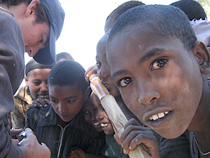
Dr. Acharya’s research focuses on the design and implementation of epidemiological studies to determine risk factors impacting clinical outcome in ocular inflammatory disease as well as clinical trials to determine the optimal treatment for these conditions. Current projects include epidemiological studies on immunosuppressive therapies, juvenile idiopathic arthritis-associated uveitis, sarcoidosis, smoking and uveitis, and clinical trials on corneal ulcers and uveitis. |
First-line Antimetabolites for Steroid-sparing Treatment (FAST) Trial
N. Acharya, T. Porco, T. Lietman, W. Enanoria, E. Browne, J. Gonzales, M. Rao
Treatment of uveitis is currently not evidenced-based. Patients often are treated with multiple immunosuppressive agents until one is found which successfully controls their inflammation. The antimetabolites methotrexate and mycophenolate mofetil are the two most commonly used immunosuppressive agents used to treat chronic non-infectious uveitis in the US. After conducting a pilot clinical trial to gather preliminary data, we are conducting an NIH sponsored multicenter clinical trial to definitively compare these therapies. The Proctor Foundation is the clinical and data coordinating center, and we will be enrolling patients at the Proctor Foundation, Oregon Health and Sciences University, and Northwestern University, in addition to international sites including Asociacion Para Evitar la Ceguera en Mexico, I.A.P. (APEC), Hospital in Mexico City (collaborator Dr. Lourdes Arellanes Garcia) and the Centre for Eye Research Australia (CERA) at Royal Victorian Eye and Ear Hospital in Melbourne, Australia (collaborator Dr. Lyndell Lim and Dr. Anthony Hall).
Discovering Infectious Pathogens (DIP) Uveitis Study
N. Acharya, T. Doan
Dr. Acharya, in collaboration with Dr. Thuy Doan and the DeRisi Lab at UCSF, is conducting the DIP Uveitis Study to develop a new method for identifying infectious causes of uveitis, an inflammatory eye disease. There are a number of causes and conditions related to the development of uveitis, and extensive investigations are often carried out to determine if the underlying cause is infectious or autoimmune-based. To confirm an infectious cause, a small sample of fluid from inside the eye may be collected for PCR or culture. However, the PCR technique is limited in the types and quantity of pathogens it can detect. Fortunately, next generation sequencing and sophisticated bioinformatics tools are starting to revolutionize our ability to identify known and previously unidentified pathogens. This study aims to use a next generation analytical approach to identify pathogens that are not routinely tested for in a clinical setting. The DeRisi lab is a pioneer in this field and has the tools and expertise to make significant strides in finding pathogens that may be responsible for uveitis of unkown cause.
Multi-Center Uveitis Steroid Treatment Trial (MUST)
N. Acharya, J. Gonzales, M. Rao
Dr. Acharya is site PI of the Multicenter Uveitis Steroid Treatment Trial (MUST), which is comparing the Retisert fluocinolone acetonide steroid implant to systemic immunosuppressive therapy for the treatment of chronic intermediate, posterior or panuveitis. This study has completed enrollment, and patients are now being followed for long-term outcomes. Dr. Acharya is serving as a protocol chair to help design future clinical trials on uveitic macular edema to be conducted with the MUST network.
PeriOcular and INTravitreal corticosteroids for uveitic macular edema (POINT) trial
N. Acharya, J. Gonzales, M. Rao
Dr. Acharya is site PI of the POINT trial, which is being conducted by the MUST Research Group out of Johns Hopkins University. The objective of this trial is to evaluate the relative efficacy of three commonly used regional corticosteroids for treatment of uveitic macular edema: periocular triamcinolone acetonide injection; intravitreal triamcinolone acetonide injection; and intravitreal dexamethasone implant. The primary efficacy measure is percent change in macular thickness from baseline to two months post-injection. Participants are followed for a total of six months in order to compare the duration of treatment effects, requirement for additional injections, and adverse effects among the three treatment arms.
Epidemiologic Studies on Uveitis
N. Acharya, E. Browne, J. Gonzales, W. Enanoria, T. Porco
Dr. Acharya’s research group is studying the predictors of clinical outcomes such as visual acuity and ocular complications in subtypes of uveitis, as well as assessing clinical outcomes in patients treated with various immunomodulatory treatments, including biologic therapies. The research group is also investigating risk factors for developing ocular inflammation, including exposure to various medications and having other concurrent medical conditions. The latter studies are being conducted in conjunction with Dr. Vivien Tham (Proctor alumna) and Kaiser Permanente Hawaii. We are also the coordinating center for a multicenter international study to validate diagnostic criteria for ocular sarcoidosis. Dr. John Gonzales from Proctor is a co-investigator for the sarcoidosis study.
Mycotic Ulcer Treatment Trials
N. Acharya, T. Lietman, S. McLeod, T. Porco, K. O’Brien, K. Ray, N.V. Prajna and other collaborators at Aravind Eye Hospital in South India
Fungal corneal ulcers tend to have poor outcomes with the commonly used treatments, natamycin and amphotericin B. Recently, voriconazole has been used to treat fungal corneal ulcers with anecdotal reports of success reported in the literature. However, there has been no systematic attempt to determine whether it is more effective clinically than the commercially available natamycin. Although there are suggestions that particular fungi respond better to one agent or another, there is little data available for physicians to make an evidence-based decision on choice of antifungal. The Mycotic Ulcer Treatment Trial (MUTT) 1 studied which topical antifungal treatment, voriconazole or natamycin, resulted in better visual acuity in patients with fungal corneal ulcers. This trial found that natamycin was associated with better visual outcomes compared with topical voriconazole. MUTT 2 is studying whether adding oral voriconazole to topical voriconazole improves clinical outcomes in severe fungal ulcers.

